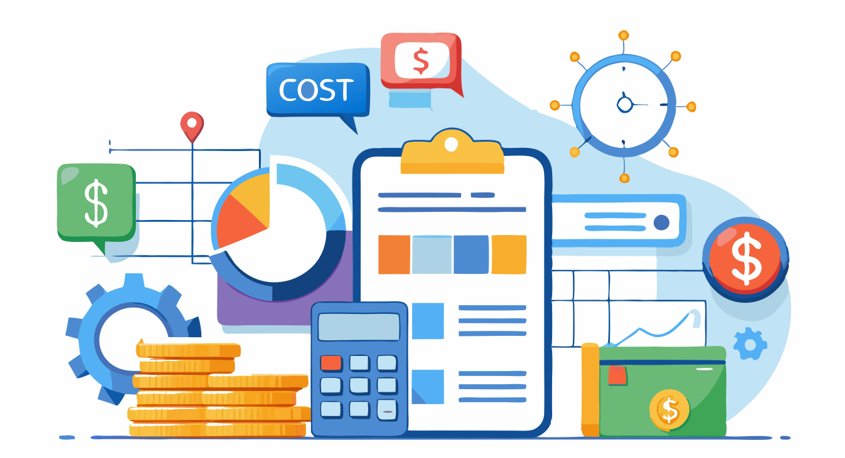
Smart Expense Control Strategies for Business Sustainability
- November 2024 Edition
- 5 mins
Effective expense control is essential for maintaining profitability and ensuring long-term business sustainability. Organisations must adopt strategies that minimise costs while maintaining quality, enabling them to remain competitive and financially resilient.
Whether you’re a small business or a large corporation, understanding where your money goes and how to allocate resources efficiently is key to making informed financial decisions. This article explores practical expense control strategies to help your organisation thrive.
Understanding Expense Control
Expense control involves managing and reducing business costs to maximise profitability without compromising operational effectiveness. This process includes:
- Identifying significant expenses that impact financial performance
- Distinguishing between controllable and uncontrollable costs
- Implementing strategies to optimise spending
- Ensuring cost reductions do not negatively affect service quality
By balancing cost-cutting initiatives with revenue-generating efforts, businesses can improve financial efficiency while sustaining growth.
8 Essential Expense Control Strategies
1. Conduct Regular Expense Audits
What gets measured gets managed. Regular expense audits help businesses pinpoint inefficiencies and areas for optimisation. This ensures that every expense serves a strategic purpose and reduces financial waste.
- Example. A retail company reviews its monthly expenses and discovers that an old software subscription is no longer in use. Cancelling the subscription saves the business $5,000 annually.
- Review financial statements and operational expenses.
- Use financial reports and dashboards to track spending trends.
- Compare budgeted vs. actual spending to identify overspending and cost-saving opportunities.
- Adopt inventory management tools (such as the ABC-XYZ classification method) to monitor resource consumption and demand.
2. Differentiate Between Controllable & Uncontrollable Costs
Categorising expenses helps businesses focus on what can be adjusted or reduced:
- Example. A consulting firm negotiates lower office rent by downsizing to a co-working space, significantly reducing controllable expenses.
- Controllable Expenses – These can be negotiated or adjusted (e.g., office supplies, marketing, discretionary travel).
- Uncontrollable Expenses – Fixed or regulatory costs (e.g., taxes, compliance fees, certain utilities). While these cannot be eliminated, strategic planning can mitigate their impact.
3. Optimise Operational Efficiency
Operational inefficiencies lead to waste and unnecessary expenses. Streamlining processes improves cost efficiency.
- Example. A manufacturing company automates its payroll system, reducing manual errors and saving 10 hours of administrative work weekly.
- Automate routine tasks using AI-driven software to reduce manual workload, minimise errors, and optimise workflow efficiency.
- Eliminate redundancies in resource allocation.
- Leverage technology, including AI-powered financial tracking tools, to improve accuracy and efficiency in reporting.
- Encourage energy-efficient practices (e.g., switching to LED lighting, optimising HVAC systems) to lower utility costs.
4. Strategic Procurement & Vendor Management
Vendor and supplier costs represent a significant portion of business expenses. Strengthening relationships and negotiating better deals can result in considerable savings.
- Example. A restaurant renegotiates its food supplier contract to secure bulk discounts, reducing ingredient costs by 15%.
- Seek bulk purchase discounts and flexible payment terms.
- Explore alternative suppliers or outsourcing non-core activities to reduce overhead costs.
- Consider strategic partnerships for cost-sharing opportunities.
5. Control Discretionary Spending
While some expenses are necessary, others can be minimised without affecting productivity.
- Example. A tech startup reduces business travel costs by switching to virtual meetings, saving thousands annually on flights and accommodations.
- Reassess business travel, entertainment, and discretionary marketing budgets.
- Eliminate underutilised subscription-based services and software licenses.
- Foster a cost-conscious culture by setting clear spending policies across departments.
6.Implement Energy & Resource Efficiency
Utility bills and operational overheads can be optimised through sustainable measures.
- Example. A corporate office installs motion-sensor lighting, reducing electricity consumption by 20%.
- Invest in energy-efficient equipment to lower electricity costs.
- Adopt remote or hybrid work models to reduce office expenses.
- Reduce paper and office waste through digital transformation.
7. Adopt Sustainable Expense Management
The World Bank projects that global waste management costs will rise to $375 billion by 2025, with much of this cost burden falling on businesses. Institute of Sustainability Studies. Sustainability-driven expense management ensures businesses reduce waste, optimise resources, and align with ESG (Environmental, Social, and Governance) principles. Beyond cost reduction, sustainability efforts improve efficiency, maintain quality, and enhance operational speed by streamlining processes and adopting greener technologies.
- Example. A multinational corporation introduced a waste recycling initiative, diverting 60% of its office waste from landfills, resulting in lower waste disposal costs and an enhanced corporate reputation.
- Implement recycling programs to reduce waste management costs.
- Transition to eco-friendly packaging and materials to cut down on excessive resource use.
- Integrate ESG-aligned procurement policies by selecting suppliers with sustainable practices.
- Utilise carbon footprint tracking tools to identify areas for reduction and improve sustainability reporting.
8. Align Expense Control with Revenue Growth
Expense control goes beyond cutting costs; it involves increasing income to maintain financial stability.
- Example. A SaaS company introduces a premium subscription tier, increasing revenue without significantly raising operational costs.
- Diversify revenue streams by exploring new market segments or product offerings.
- Invest in employee training and development to improve productivity and service quality.
- Leverage AI-powered data analytics to gain deeper insights into customer behaviour, optimise pricing strategies, and enhance financial decision-making.
Overcoming Common Expense Management Challenges
While expense control is necessary, it comes with challenges such as low employee motivation, lack of collaboration, and resource constraints. To address these:
- Example. A logistics firm improves employee engagement by offering performance-based bonuses, ensuring that cost-cutting measures do not demotivate staff.
- Improve cross-departmental collaboration to streamline workflows and reduce inefficiencies.
- Invest in recognition and career growth opportunities to maintain employee morale.
- Enhance internal communication to prevent misalignment and financial leaks.
Final Thoughts
Effective expense control is more than cutting costs; it focuses on optimising spending to drive profitability and sustainable growth. Businesses that adopt data-driven insights, operational efficiency, and strategic cost reductions are better positioned to navigate economic fluctuations and market challenges.
Through continuous expense monitoring, internal efficiency improvements, and alignment of cost control with revenue growth, organisations can achieve long-term financial success while maintaining high-quality service delivery.
Further Reading & Resources
For those looking to explore further, the following resources provide valuable insights and best practices:
- The Times; Small can be beautiful when it comes to cutting costs – This piece discusses innovative approaches to cost-cutting, including how questioning long-standing practices can lead to significant savings.
- McKinsey & Company; Five Ways CFOs Can Make Cost Cuts Stick – Strategies for implementing cost reductions that align with long-term financial sustainability
- CFO.com; How AI is Transforming Expense Management – A look at how artificial intelligence is revolutionising expense tracking and control.
- Forbes; The Future of AI in Financial Services – Exploring the growing impact of AI-driven financial tools on expense control.
- Book Recommendation; Profit First by Mike Michalowicz – A structured approach to business finance that prioritises profitability through better cash flow management.

